Erin Driessen – 5 July, 2012
If these paintings are looked at as sculptural objects the exhibition takes on a whole new set of ideas. The frames can be seen as sculptures. Certainly in the third version, the frames resemble paintings in the way they are spaced and how they sit flush with the wall. The shadows they cast give them an undeniable three-dimensionality, something colour field and expressionist painting was generally trying to deny.
Fiona Connor has reformulated the Dunedin Public Art Gallery’s existing exhibition Colourbox, which is made up of neo-expressionist and colour field paintings by New Zealand artists including Philip Clairmont, Gretchen Albrecht, Toss Woollaston and Judy Millar. Connor has constructed metal, free-standing frames or stands on which the works are displayed or transported during reconfigurations of the exhibition by new curators, whom she has chosen and invited. Other than the stands, she has added no work of her own. This show is about ‘how,’ not ‘what.’
Connor’s use of the word ‘mural’ is interesting. A mural is often the product of a collaborative effort by a group of people wishing to convey a specific message. The way in which that message is sent, however, differs depending on who is sending it. Each different mural designer seeks to send the same message, using different means. Here, that idea is turned around, as each different curatorial group seeks to send a different message, using the same means.
The exhibition is staged in one room on the first floor gallery. Before the viewer can properly enter the room, they are confronted by a stand-alone piece of white wall, which displays text informing visitors whose version of the show they are about to see, depending on the schedule. I visited it during its third of four incarnations, when it was curated by Adam Elliot, Spencer Hall, Clarke Hegan, Jed McCammon, Sam Oram, Phoebe Thompson, and Hamish Wadworth. The group used the original layout of Colourbox, but their show consisted of five paintings and seven empty frames. The twelve objects are evenly placed around the edge of the room in a standard layout, forming an inner layer apart from the white wall.
The inner ring is however broken in two, as the empty stands are placed across two adjacent walls, and the paintings are placed across the other two, effectively drawing an imaginary diagonal line across the room. The white cube is therefore separated into two triangular sections. The stands are white and differ in size; they are lit so the top bar casts a very dark shadow on the wall, and the two side bars of each frame cast multiple vertical shadows.
The paintings by contrast sit in darkness, not lit at all. The five works left on display by the current curatorial group are Judy Millar’s Working the Green (2003), Gretchen Albrecht’s Cushioned Fall (1973), an untitled work by Philip Trusttum (1963), Toss Woollaston’s Wellington (1972), and Helensville 3 (1971) by Colin McCahon. They are arranged left to right, in my opinion from brightest to quietest. There is a sense of time passing either forward or backward, and momentum rising or falling, depending from which end of the wall you start. Each of the empty frames is designated for a specific yet invisible work. The five visible paintings were hung on nails left by the previous curators.
The disruptive piece of wall encountered at the entrance plays with the emptiness of the frames. It is initially anticlimactic to have traversed the wall and found what looks to be an incomplete exhibition. In the first version, curated by Connor and Aaron Kreisler (who also curated the original Colourbox), visitors were confronted with the constructed stands displaying the backs of paintings. The stands were placed throughout the room, not just against the wall, so that the viewer had to weave through the works.
The second version was curated by artists Michael Parr and Blaine Western, who decided to exploit their interest in and knowledge of architecture. They placed all of the works on one side of the room, compressing the space and playing with the idea of the mural as a wall. The works were covered in sheets while they were being handled and moved, and Parr and Western responded to the sculptural aesthetic, leaving the sheets to obscure the paintings. The mural design therefore became a denial of, not a yielding to, the painted surface.
The idea that these works can be interpreted or experienced differently according to their spatial arrangement is difficult to accept. They are fundamentally abstract paintings brought together by the simple fact they were all by New Zealand artists who experimented with colour. Non-figurative works displayed in a group exhibition generally lend themselves to isolated appraisal, no matter what other artworks surround them. Connor highlighted this in she and Kreisler’s initial layout, where the works stood alone, on their own stands, away from the wall, not aligned with other paintings.
However if these paintings are looked at as sculptural objects instead, the exhibition takes on a whole new set of ideas. The frames can be seen as sculptures in their own right. Certainly in the third version, the frames resemble paintings in the way they are spaced and how they sit flush with the wall. The shadows they cast though, give them an undeniable three-dimensionality, something colour field and expressionist painting was generally trying to deny. The stands can also be seen as Minimalist as they are repeated shapes in serial patterns, creating a kind of gestalt. Minimalism in its first incarnations in America was a rejection of Abstract Expressionism.
The third version of this exhibition creates a provocative tension between painting and sculpture. The different incarnations of the show work together to subvert the notion that art works by progression or evolution. I don’t think interpretations of the individual paintings themselves are much changed, but the simple wheeling of a couple of paintings from one side of the room to the other creates engaging oppositions and complex symmetries. In the words of Philip Clairmont, quoted in the gallery text for Colourbox, “The act of remaking or transforming an object is magic.”
Erin Driessen
Recent Comments
Keir Leslie
The physical integrity of the art work is very much not the only moral obligation of the curator. Legalities aside ...
Yolunda Hickman
Exactly. I'm not even entirely sure where I stand, but an interesting discussion to have. If it was a curator's ...
Roger Boyce
In this discussion Connor's name is raised as sole arbiter of what became (albeit temporarily)of the paintings drafted into a ...
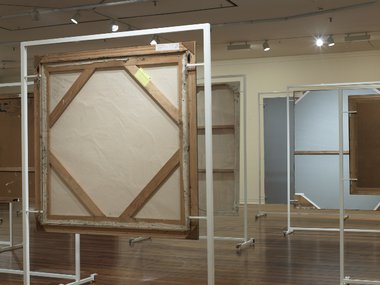
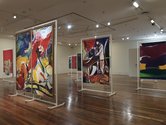
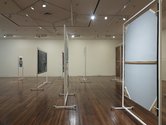
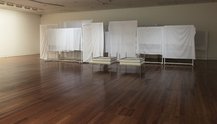
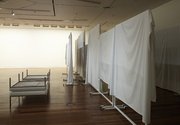
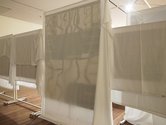


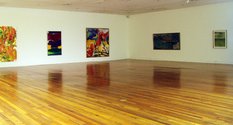
 Two Rooms presents a program of residencies and projects
Two Rooms presents a program of residencies and projects Advertising in this column
Advertising in this column

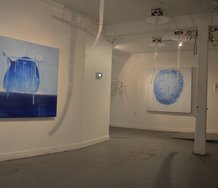
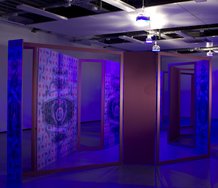
This Discussion has 27 comments.
Comment
John Hurrell, 2:28 p.m. 5 July, 2012 #
Erin, while the institution probably has the legal right to exhibit paintings as sculptures if it so chooses (especially if it owns them) does it have the moral right? Some of these painters might be quite upset about the way the fruit of their labours have been displayed here. I wonder if they were consulted?
Erin Driessen, 4:03 p.m. 5 July, 2012 #
I think the only moral responsibility the gallery has to the painting or the artist is to not damage the work, and here the conservator was involved so the works were not harmed. I didn't read anything about the artists being consulted re: their work being displayed underneath sheets, facing away from the viewer, or on stands instead of hung on the wall. With this exhibition I hope the artists can or could see the curatorial decisions as quite removed from the forms or subject matter of the paintings. To reformulate an exhibition of figurative rather than abstract work would probably have added the complexities you raise. But here, there's no moral judgment on behalf of the curators as far as I can see. All of the artists are established NZ painters also, so I think their reputations or bodies of work precede what is being done here. On that point, though, I guess I could see some viewers taking offense on the artists' behalf.
John Hurrell, 4:37 p.m. 5 July, 2012 #
I guess I'm getting at a tacit agreement by which works are sold to institutions on the understanding they will be displayed according to certain exhibiting conventions: an unspoken contract to which artists expect the gallery to stick.
Of course I'm aware artists like Michael Asher and Louise Lawler came along with their institutional critiques and changed the exhibiting rules. Nevertheless there are expectations that when a work goes into a collection it will be presented within a certain format so that the properties explored by the artist can be appreciated. If they are ignored or hidden there is a moral issue I think.
Warren Feeney, 7:37 p.m. 5 July, 2012 #
I have concerns about this exhibition and it is in the manner in which the curator’s presence gets in the way of each work of art. (Untitled) Mural Design seems like an idea that came up at morning tea in the gallery - a one-liner from someone on the staff that raised a 'what if we...' question. My experience in seeing this installation was that the works in themselves were far more interesting and engaging than the conceit of the idea to display them and the curatorial proposition this show was built on was ultimately incapable of sustaining interest in the content it chose to contexturalise.
John Hurrell, 7:55 p.m. 5 July, 2012 #
Fiona's project here comes from her artist's residency early this year. It would be interesting to hear how, after the last stage is completed, all four installations can be analysed. Four varieties of social relationship perhaps, and four formal arrangements that lead to where, I wonder?
John Hurrell, 8:26 p.m. 5 July, 2012 #
Maybe there are ethical problems here similar to the dilemma caused in Heather Galbraith's Telecom Prospect 2007 by The Association of Collaboration's Art Mobile Response Unit, where the brightly coloured stand was interpreted by some as sabotaging other contributors to the show.
Hanna Scott, 8:37 p.m. 5 July, 2012 #
Is any body else experiencing vivid flashbacks to Julian Dashper's 'Mural for a contemporary house (No. 4)' 1988, Coll. Te Papa.?
Owen Pratt, 9:27 p.m. 5 July, 2012 #
I agree that the artists moral rights are being trampled here but it is a bit rich to expect mea culpas from curators after 100 years of transgressive and iconoclastic practice from artists though. Pots and kettles eh?
John Hurrell, 11:21 p.m. 5 July, 2012 #
Good to air the subject though - to look at it.
I think artists are far more passive now with municipal galleries than say twenty years ago. So many more (because of increase of tertiary institutions) and it is so competitive to get shows.
Roger Boyce, 1:28 a.m. 6 July, 2012 #
Moral consideration in connection to artworks?
How 19th century.
I'd submit that the only thing moral (or immoral) about artworks lies in their capacity (or incapacity) to reward invested time. Time, 'all a man's got and all he's ever gonna get'- to paraphrase the fictional William Munny.
Artworks associated with obsolete (or exhausted) strategies are incapable of equitably rewarding a viewer for time invested.
As far as I can clairvoyantly tell - from distant-viewing - the works under discussion in the review, and in the after-comments, are radically autonomist and thus novel to no one but catechized essentialists.
'S funny that abstract paintings were exclusively employed in this work. Abstract artworks, lacking figuration, are arguably divorced from moral dimension. Works having a moral dimension (i.e narrative) are incomplete structures....requiring a viewers moral response for their completion.
The converse conceit of abstraction is that it is positioned as immaculately conceived, self-sufficient objects. To (simply) formally re-position autonomous objects into putatively unconventional (but actually capita F formalist) re-arrangements is to participate, rather than transgress, novelize, or divert a hoary conceit.
Morality sneaks into the argument by way of speculation re an institutionally collected artist's putative wishes.
Living artists, as a courtesy, could be asked if they cared to (or objected to) having their works drafted into service by another artist (or, for that matter, curator).
If I was being asked such permission my decision would be situational. Based subjectively on the time/reward model put forward in my earlier paragraph.
It's 1 AM and I can't be held accountable for the content or lucidity of the foregoing textual folly.
I'm sorry already.
Be Well
Erin Driessen, 9:30 a.m. 6 July, 2012 #
I agree with Roger.
If I saw Andre's bricks hung on the wall as a painting, I would know it's not "supposed" to be that way, but it would prompt me to consider the intricacies. I think even he would appreciate it, even if it didn't improve the work (which it wouldn't, ha). It's clearly been long enough since Ab Exp and Minimalism were 'shocking', and the properties explored by the artists in each are generally well-known, so that now I think some different moves are welcome, even if they don't really work. They were two kinds of art that began as challenges, and are now seen as conventional and kind of used up. Continuing the spirit of screwing around with the conventions is essential.
This idea of "that offends me, therefore it should change" perplexes me. Surely artists and art viewers can by now confront their own reactions and see them as a sign of something interesting, rather than hold onto a misplaced sentiment or sense of entitlement. To whom does art belong, really?
I am sure there are cases where the moral issue is a real thing, but personally I don't think it's of real concern here.
Erin Driessen, 9:31 a.m. 6 July, 2012 #
Plus, let's not forget that Fiona is an artist, first.
Roger Boyce, 1:12 p.m. 6 July, 2012 #
I'm more awake now than at 1 AM. But still in doubt re the advisability of having rung-in on this lose-lose exchange.
With all due respect to Ms. Driessen's minimalist exemplar speculations:
Having had the dubious pleasure of direct dealings with Mr. C. Andre I'd doubt very much he'd "appreciate" seeing his bricks displaced from prescribed/prosrcibed floor context - to a wall. I'd suggest that given Carl Andre's infamous tendency to choler one could conceivably risk an extra-judicial punch in the nose...as he was known to deliver during aesthetic 'discussions' held on the sidewalk just outside the Cedar Tavern.
As to Owen Pratt's dramatic and presupposing incantation of the term "denigration".....
1.To attack the character or reputation of; speak ill of; defame.
2. To disparage; belittle:
....in regard to the re-fielding of the paintings in question, is another story.
Moral rights and respect have more to do with maintaining (or increasing) efficacy (and the object's cultural status) than they do with copyright. Whatever the law.
As an artist it is (as far as I'm concerned) a significant part of my job description to hold the law be damned or, better yet, the law's an ass. The only law - in terms of aesthetics and art making and audience investment in that aesthetic - I think should be practically considered, by artists and curators alike, is this particular law of thermodynamics: "Heat and work are forms of energy transfer"
The work, at least as described by review text and image (and to be fair I should give the work the benefit of the doubt of not having seen it in the flesh) produces little heat (or, for that matter, light) and transfers nothing more than a multi-fold map of a sadly shop-worn track.
I'm going to go paint now.......talk about a shop-worn track.
Owen Pratt, 2:31 p.m. 6 July, 2012 #
happy painting.
fyi http://www.copyright.org.nz/viewCasestudy.php?case=450
Roger Boyce, 7:53 p.m. 6 July, 2012 #
OK. Taking a dinner (string-beans + roasted chicken thighs) break from painting...while listening to Booker T and the MG's. I'll risk the unconscious inhalation of dinner and Booker T to respond.
I'll concede that, at least according to your link, that the artists who've had their work rearranged have a reasonable precedent for a case. But.
The artworld's a small village - so there's much at risk (by pursuing such a case) and what to be gained?
I remember an artist (painter) who was on an international exhibition circuit that regularly culminated in a capstone solo show at Bruno Bischoffberger.
This artist had a spacious Soho loft, friends who came to his soirees wearing Comme de Garcons and Prada and life was looking nothing but up. He had an idea that he was 'somebody' to be reckoned with. That he (or rather his work) had "moral rights".
So, when he was wronged by a prominent (now deceased) NYC gallerist he resorted to law...with the idea of being made whole again.
Some years later, after his star had plummeted from the art firmament (as a direct result of seeking legal remedy) I was strolling around the upper east side - in an area of the neighborhood that featured op-shops dedicated to various mortal charities. Charities dear to the hearts of the upper east siders.
Lo and behold, in the window of one of these thrift stores was a painting by our erstwhile and litigious painter. Price $5000. A dramatically lower retail price than his work had formerly commanded.
This is true a story sans moral.
If one must have moral endings to a story - wherein a protagonist seeks the moral satisfaction of a fair judgment - after being inarguably wronged - then may I suggest (for its cautionary utility and for its pure entertainment value )Heinrich von Kleist's novelette - Michael Kohlhaas.
I'll now return to the dubious pleasure of fiddling with a postage stamp sized section of painting until my neck and shoulder insist otherwise.
Owen Pratt, 11 a.m. 6 July, 2012 #
My understanding of moral rights is that they are the right to not have your work denigrated by the people responsible for its care. It is one or the few rights artists have under copyright law in this country.
Whether the moral rights were respected here or just run roughshod over, not even considered by the participants, seems slightly different in each incarnation of the experiment. Unlike the infamous McCahon/Kelvinator job by Wedde at Te Papa which clearly expressed more about the curator than the art.
Owen Pratt, 11:05 a.m. 6 July, 2012 #
whether. (sp)
Chloe Geoghegan, 9:32 p.m. 6 July, 2012 #
A good 'the artist-run space did it first' example: 'Nicht So Schlimm' 23 June - 11 July, 2009 at the High Street Project. No curators, visitor numbers, conservators, art movements or chicken flavoured two-minute noodles, just timely experiments in earnest.
http://hspgallery.blogspot.co.nz/2009/07/nicht-so-schlimm-23-june-11-july-2009.html
Owen Pratt, 11:12 a.m. 7 July, 2012 #
similar form but unless the artists used other peoples work (perhaps without their permission) then this is an artistic statement where the show involving curators was a controlled recontextualisation, which in my opinion is quite different.
Roger Boyce, 8:47 p.m. 7 July, 2012 #
Now, I DID happen to see that Nicht So Schlimm HSP show. And to be blunt it was a visually demoralizing (there's that dang 'moral' word again) affair...in all its various 'curatorial' incarnations.
I had a voluble public exchange with (the fictional) Harold Grieves (publisher of the John Dory report and erstwhile mentor to Christchurch's attenuated answer to Alfred Jarry) who I think - one never knew for sure when dealing with the sphinx-like former management of the now-moribund High Street Project - organized the fiasco.
I seem to recall that he had sought and got permission from the artists to be allowed to perform a sort of delegated curatorial reach-around on their paintings.
Harold aka Hamish thought it was a swell idea and I thought not. Viewing the various configurations felt to me like (almost literally) a sharp stick in the eye. Maybe it's a generational thing? Maybe the kids have developed a taste for sharp sicks in and around the eye? I dunno.
I saw this sort of thing (albeit fancier versions) going on at the bigger art museums in the US before I fled. But one had to be a fairly fancy practitioner to be invited to dick around with (say) MoMA's collection. But it was all the rage for awhile - and as was inevitable with curatorial 'rages' it spread like aesthetic herpes across US institutions. I think the eruptions were going dormant before I absconded the continent of my birth.
I'm waffling on, as the American I once was. My apologies.
Yolunda Hickman, 4:43 p.m. 7 July, 2012 #
How far can the artist go?
As already mentioned, in Fiona Connor's work, the paintings themselves were not vandalised, just relocated.
In a similar way Roisin Byrne may argue that she 'relocated' Simon Starling's rhododendrons (http://www.roisinbyrne.co.uk/you-dont-bring-me-flowers-anymore/). But Byrne's work destroys Starling's work for its own existence. This act undermines the intention of the original work which relies on specifics of location.
Arguably, the paintings Connor uses do not need to be on a wall to be the same work, hence 'Untitled (mural design)'. The physical integrity of the paintings is maintained which is where the only moral obligation lies.
Owen Pratt, 6:52 p.m. 7 July, 2012 #
"...or a treatment that prejudices the creator’s honour or reputation."
Nz Copyright Act
Yolunda Hickman, 10:32 a.m. 8 July, 2012 #
In this installation form, the work is Fiona Connor's. Hung on the wall, they are Clairmont's, Millar's, Woollaston's. Connor makes no permanent claim or irreversible 'treatment' to inhibit the original form.
John Hurrell, 10:42 a.m. 8 July, 2012 #
Sure Yolunda that is true. But even if temporary there are grounds for disquiet. It is compulsory participation isn't it, if they are not asked?
Roger Boyce, 11:40 a.m. 8 July, 2012 #
In this discussion Connor's name is raised as sole arbiter of what became (albeit temporarily)of the paintings drafted into a 'newer' spatial work.
In this specific case, and in US cases I cited generally, the institution (obviously) has/had some culpability as well. If the credit (or luster) for a successful exhibition accrues to an institution then debit does as well in the case of a failed creative effort.
I'm not saying that Connor's piece succeeded or failed as a creative effort (as I didn't actually view the 'body') but if there is a moral rights (theoretically speaking, as any legal claim by the drafted artists would be politically ill advised) to be considered then the sanctioning and collecting institution is in play as well.
All of this makes for an interesting (at least to me) discussion. But at the end of the day it devolves into a theological debate - as the practicalities and politics of suing museums, galleries, and dealers is a showy form of professional suicide. A move any canny artist would stay well away from. Those (non artists) who sit on the sidelines and cheer on the exercise of moral rights (at least in this case) would be right at home in the bread and circus stands of the Roman Coliseum. My money's on the lions.
Yolunda Hickman, 12:30 p.m. 8 July, 2012 #
Exactly. I'm not even entirely sure where I stand, but an interesting discussion to have.
If it was a curator's decision (albeit, potentially misjudged), would 'installation strategy' equate to an adequate defense?
Keir Leslie, 4:57 p.m. 8 July, 2012 #
The physical integrity of the art work is very much not the only moral obligation of the curator.
Legalities aside --- given the poor state of development of the law, and the paucity of New Zealand authority, it is pretty foolish to guess what it is --- the moral duties of curators are pretty clearly more extensive than `don't break the art'.
Participate
Register to Participate.
Sign in
Sign in to an existing account.